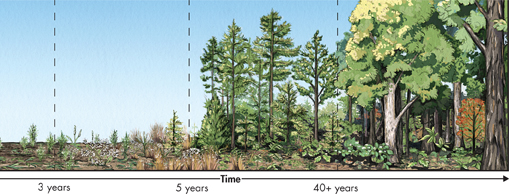The first species to colonize barren areas are called pioneer species—named after rugged human pioneers who first settled the wilderness. After pioneers created settlements, different kinds of people with varied skills and living requirements moved into the area. Pioneer species function in similar ways. One ecological pioneer that grows on bare rock is lichen—a mutualistic symbiosis between a fungus and an alga. Over time, lichens convert, or fix, atmospheric nitrogen into useful forms for other organisms, break down rock, and add organic material to form soil. Certain grasses, like those that colonized Krakatau early on, are also pioneer species.
Secondary Succession Sometimes, existing communities are not completely destroyed by disturbances. In these situations, where a disturbance affects the community without completely destroying it, secondary succession occurs. Secondary succession proceeds faster than primary succession, in part because soil survives the disturbance. As a result, new and surviving vegetation can regrow rapidly. Secondary succession often follows a wildfire, hurricane, or other natural disturbance. We think of these events as disasters, but many species are adapted to them. Although forest fires kill some trees, for example, other trees are spared, and fire can stimulate their seeds to germinate. Secondary succession can also follow human activities like logging and farming. An example of secondary succession is shown in Figure 4 –13.
Why Succession Occurs Every organism changes the environment it lives in. One model of succession suggests that as one species alters its environment, other species find it easier to compete for resources and survive. As lichens add organic matter and form soil, for example, mosses and other plants can colonize and grow. As organic matter continues to accumulate, other species move in and change the environment further. For example, as trees grow, their branches and leaves produce shade and cooler temperatures nearer the ground. Over time, more and more species can find suitable niches and survive.
BUILD Vocabulary
WORD ORIGINS The origin of the word succession is the Latin word succedere, meaning “to come after.” Ecological succession involves changes that occur one after the other as species move into and out of a community.
 In Your Notebook Summarize what happens in primary and secondary succession.
In Your Notebook Summarize what happens in primary and secondary succession.

FIGURE 4–13 Secondary Succession Secondary succession occurs in disturbed areas where remnants of previous ecosystems—soil and even plants—remain. This series shows changes taking place in abandoned fields of the Carolinas' Piedmont. Over the last century, these fields have passed through several stages and matured into oak forests. Changes will continue for years to come.
dTable of Contents
- Formulas and Equations
- Applying Formulas and Equations
- Mean, Median, and Mode
- Estimation
- Using Measurements in Calculations
- Effects of Measurement Errors
- Accuracy
- Precision
- Comparing Accuracy and Precision
- Significant Figures
- Calculating With Significant Figures
- Scientific Notation
- Calculating With Scientific Notation
- Dimensional Analysis
- Applying Dimensional Analysis




